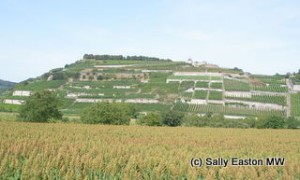German pinot noir reveals itself

Ihringer Winklerberg, Baden
Germany has long kept secret its world class pinot noirs, or spätburgunder, though over the past few years has been slowly letting in the rest of the world on these wonderful wines. Indeed, they hit the headlines in the UK recently, when German versions of this grape variety hauled seven out of the top ten spots in an international blind tasting, tasted almost solely by UK trade folk.
It surprises many to learn of the extent of pinot noir in Germany. It was only after the planting boom in the USA that followed on from the 2004 Sideways film, that Germany’s increasing plantings of pinot noir fell into third place. It has 11,300 hectares, behind the USA’s 15,000 hectares and France’s 30,000 hectares, (including the 13,000ha that go into producing Champagne).
At this modest, medium-term increase in plantings, pinot noir, which also ranks the third most planted variety within Germany, is beginning to give the country’s most planted grape variety, riesling, a run for its money. Plantings of second-placed rivaner (Müller Thurgau), declined by a third in the decade to 2010, whilst spätburgunder increased by more than 20% in the same period. At this rate it will be only a couple of years before spätburgunder moves into the number two slot.
As to where pinot noir is grown in Germany, more than three quarters of is found in just three regions – Baden, with 5,743 ha, Pfalz, with 1,588ha and Rheinhessen, with 1,363 ha. Baden is a 50km eastwards hop across the south-north flowing river Rhine from Alsace, whilst Pfalz and Rheinhessen are a geographic northward extension of the Alsace vineyards on the left bank of the Rhine. So the variety hasn’t migrated too far from its Burgundian origins. Indeed it had been the Cistercian monks who brought the variety to Baden in the 13th century from Clairvaux in Burgundy.
In the south west corner of Germany, Baden alone accounts for more than half of pinot noir plantings. And it is the volcanic, Kaiserstuhl mountain where the variety performs its best. This southerly region gets the best of the sunshine and is warm by cool, northern European standards. Warm air is also drawn up from the distant Mediterranean sea, crossing the Belfort Gap, or Burgundy Gate, which is a lower lying plateau between the southernmost end of the Vosges mountains and the northern end of the Jura mountains.
Kaiserstuhl, almost uniquely in the wine world, has limestone melted into the volcanic lava, so pinot noir was a good bet to plant here. Arne Bercher of Weingut Bercher, whose family have been making wine in the Kaiserstuhl for over 300 years, explained “pinot noir does nicely in Kaiserstuhl because of the minerally volcanic soils. It is something that sets this region apart from Baden and the rest of Germany. The wines have higher ageing potential” he added “and take longer to develop.”
Tasting notes, in situ, August 2011
Weingut Manz, Oppenheimer Herrenberg, Spätburgunder Trocken Kalkstein 2007, Rheinhessn €12.50
13.5%. 30% new oak. Sweet cherry and blueberry fruits on the perfumed nose. Palate attack has aromatic tarry hints. Smooth, and nicely balanced. Decent.
Weingut Manz, Oppenheimer Herrenberg, Spätburgunder Trocken M *** 2007, Rheinhessen €18.50
14%; all new oak. Bit of spicy rumtopf on the nose, then more pinot noir character comes through on palate attack with darkly spiced cherries, though this is erring to nice red wine, rather than wine with typical pinot noir attributes. Texture is attractively smooth, and wine has in-palate length with positive evolution of flavours. Good wine.
Weingut Eckehart Gröhl, Blauer Spätburgunder Trocken Alte Reben 2009. €9
1,200 to 5,000 litre oak casks used for his ‘basic’ quality. Bright cherry fruit, with smooth, crunchy, clean, fruit clarity. Good varietal definition, and medium length. More than an everyday pinot noir. Good.
Weingut Eckehart Gröhl, Oppenheimer Herrenberg, Pinot Noir Trocken, in barrique, 2006, €18
14%, 80% new French oak, on yeast for two years. Dark char and curry spices, smooth and sweet palate, warmth coming through. Quite muscley, and in a strong red wine sort of way.
Britzingen Winzergenossenschaft, Muggardt, Britzinger Spätburgunder QbA trocken 2008
Muggardt, a 1.5ha vineyard at 400m in Black Forest, on a very steep, south-facing limestone slope, owned by the co-op and two individuals. New barriques and older oak. Planted 2004, with first vintage in 2006.
Medium pale, aromatic, hint of perfumed tar. Fresh and perky acidity, nicely balanced with crunchy fruit intensity. Smooth, fine grained texture. Really nice and refreshing, not so complex, but potential is there. Immediately vg.
Dr. Heger, Mimus, Ihringer Winklerberg, Spätburgunder Barrique Trocken 2007
Very pale colour. Light, juicy red cherry, youthful, quite bit spiciness mid palate with elegant fruit. Good.
Dr Heger, Ihringer Winklerberg, Spätburgunder, Grosses Gewäches, Barrique trocken 2008
30% whole clusters of German clones. Floral cherry nose, light entry, savoury, tarry spice core with dry baked red cherry. Elegantly intense. Good
Dr. Heger, Ihringer Winklerberg, Spätburgunder, Grosses Gewäches Barrique trocken ‘Hausleboden” 2009
Oldest vineyards, planted 1954. Pale cherry colour. Juicy, red cherry, smooth, fine-grained texture, complex and seriously textured, in filigree fashion. Wholesome, seamless and ridiculously tasty.
Weingut Bercher, Jechtinger Eichert, Spätburgunder Spätlese Trocken 2008
Medium pale, red cherry colour. Bright, juicy red cherry nose, smooth attack, wild strawberries. Supple, sweet berry fruit with savoury backbone. Nice.
Weingut Bercher, Feuerberg, Spätburgunder Grosses Gewäches 2008
40% new barriques. Pure south slope. Dark cherry colour. Hint rumptof, rich, full body, quite chewy mid palate. Hints of graphite. A muscley style that’s well balanced and should mellow. Good.
My research trip was sponsored by Deutsches Weininstitut.



